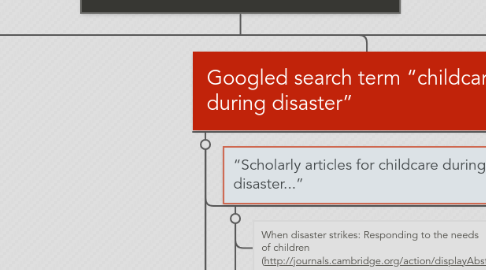
1. Population Research 'Emergency Response' Links via d2l.arizona.edu
1.1. Emergency Response (http://www.niehs.nih.gov/health/topics/population/response/index.cfm )
1.1.1. What NIEHS is Doing on Emergency Response
1.1.1.1. Preparing for the unthinkable (http://www.niehs.nih.gov/news/newsletter/2015/7/inside-preparing/index.htm)
1.1.1.2. HHS workshop aims to speed up public health emergency response (http://www.niehs.nih.gov/news/newsletter/2012/11/spotlight-hhs/index.htm)
1.1.1.3. Mobile technologies poised to aid training and emergency response (http://www.niehs.nih.gov/news/newsletter/2012/11/spotlight-mobile/index.htm)
1.1.1.4. NIEHS WETP Emergency Preparedness Resource Page (https://tools.niehs.nih.gov/wetp/index.cfm?id=556)
1.1.2. Responders Health Monitoring and Surveillance (ERHMS) Document and Guide for Key Decision Makers (http://nrt.sraprod.com/ERHMS/ Emergency)
1.1.3. DISASTER PREPAREDNESS: Better Planning Would Improve OSHA (http://www.gao.gov/assets/260/258137.pdf)
1.1.4. WETP Support of the National Response Plan (http://tools.niehs.nih.gov/wetp/index.cfm?current=307 )
1.1.5. Natural Disasters and Environmental Health: A Selected Bibliography (http://www.niehs.nih.gov/health/assets/docs_f_o/natural_disasters_and_environmental_health_a_selected_bibliography_508.pdf)
1.1.5.1. Disasters & Emergencies: Hurricanes (http://www.hhs.gov/emergency/hurricane.html)
1.1.5.2. Disaster : Myths that just won’t die (http://www.crid.or.cr/digitalizacion/pdf/eng/doc16056/doc16056.htm)
1.1.5.3. Environmental health in emergencies and disasters : A practical guide (http://www.crid.or.cr/digitalizacion/pdf/eng/doc14606/doc14606.htm )
1.1.5.4. Flooding and communicable diseases fact sheet (http://www.who.int/hac/techguidance/ems/flood_cds/en/index1.html)
1.1.5.5. A guide to emergency health management after natural disaster (http://www.crid.or.cr/digitalizacion/pdf/eng/doc13926/doc13926.htm)
1.1.5.6. Guide to Sanitation in Shelters and Camps (http://www1.paho.org/english/dd/ped/te_albe.htm)
1.1.5.7. Humanitarian Assistance in Disaster Situations (http://www1.paho.org/English/PED/pedhumen.pdf)
1.1.5.8. Key Facts About Infectious Disease (http://www.bt.cdc.gov/disasters/hurricanes/infectiousdisease.asp)
1.1.5.9. Key Facts About Hurricane Recovery (http://www.bt.cdc.gov/disasters/hurricanes/recovery.asp)
1.1.5.10. Recovering from Disaster (http://www.fema.gov/areyouready/recovering_from_disaster.shtm)
1.1.5.11. HSUS Disaster Center: preparedness tips, emergency services (http://www.humanesociety.org/issues/animal_rescue/tips/pets-disaster.html)
1.1.5.12. Food and Water in an Emergency (http://www.fema.gov/pdf/library/f&web.pdf#search=%22emergency%20food%20and%20water%20supplies%20site%3Afema.gov%22)
1.1.5.13. FDA Offers Valuable Food Safety Information for Hurricane, Power Outages, and Flood Aftermath (http://www.cfsan.fda.gov/~dms/fsdisas.html)
1.1.5.14. NLM Disaster Information Management Research Center (http://sis.nlm.nih.gov/dimrc.html)
1.1.5.15. 24-Hour Program Industrial Emergency Response, Operation-Level (SEIU Emergency Response Awareness Level Workbook) (http://www.niehs.nih.gov/health/assets/docs_a_e/24hour_program_industrial_emergency_response_operationlevel_508.pdf)
1.1.5.16. EHP Student Edition Lesson: Caring for Children Amidst Chaos (http://www.niehs.nih.gov/health/assets/docs_a_e/ehp_student_edition_lesson_caring_for_children_amidst_chaos_508.pdf)
1.1.5.17. EHP Student Edition Lesson: What's the Plan? (http://www.niehs.nih.gov/health/assets/docs_a_e/ehp_student_edition_lesson_whats_the_plan_508.pdf)
2. Googled search term “childcare during disaster”
2.1. “Scholarly articles for childcare during disaster...”
2.1.1. When disaster strikes: Responding to the needs of children (http://journals.cambridge.org/action/displayAbstract?fromPage=online&aid=8231178&fileId=S1049023X00001448)
2.1.2. Parenting in the wake of disaster: Mothers and fathers respond to Hurricane Katrina (http://disaster.colostate.edu/Data/Sites/1/cdra-research/parentingindisasterpeekandfothergill.pdf)
2.2. Child Care Emergency Preparedness Toolbox (http://www.gsa.gov/graphics/pbs/Child_Care_Emergency_Preparedness_Toolbox.pdf)
2.3. Child Care Resources for Disasters and Emergencies (http://www.acf.hhs.gov/programs/occ/resource/child-care-resources-for-disasters-and-emergencies)
2.4. Family Child Care Emergency Preparedness Guide (http://www.dhhs.nh.gov/dcyf/cdb/documents/famcareprepguide.pdf)
2.5. Disaster Checklist - Save the Children (http://www.savethechildren.org/site/c.8rKLIXMGIpI4E/b.8777055/k.18AB/Get_Ready_Get_Safe_Plan_Ahead.htm)
2.6. Disaster Emergency Evacuation Preparedness (http://www.azdhs.gov/documents/licensing/childcare-facilities/training/deep-manual.pdf)
3. Google search term “what to know during a disaster”
3.1. Natural Disasters (https://www.ready.gov/natural-disasters)
3.1.1. Drought (https://www.ready.gov/drought)
3.1.2. Earthquakes (https://www.ready.gov/earthquakes)
3.1.3. Extreme Heat (https://www.ready.gov/heat)
3.1.4. Floods (https://www.ready.gov/floods)
3.1.5. Hurricanes (https://www.ready.gov/hurricanes)
3.1.6. Landslides & Debris Flow (https://www.ready.gov/landslides-debris-flow)
3.1.7. Extreme Weather (https://www.ready.gov/severe-weather)
3.1.8. Space Weather (https://www.ready.gov/space-weather)
3.1.9. Thunderstorms & Lightning (https://www.ready.gov/thunderstorms-lightning)
3.1.10. Tornadoes (https://www.ready.gov/tornadoes)
3.1.11. Tsunamis (https://www.ready.gov/tsunamis)
3.1.12. Volcanoes (https://www.ready.gov/volcanoes)
3.1.13. Wildfires (https://www.ready.gov/wildfires)
3.1.14. Extreme Cold & Winter Storms (https://www.ready.gov/winter-weather)
